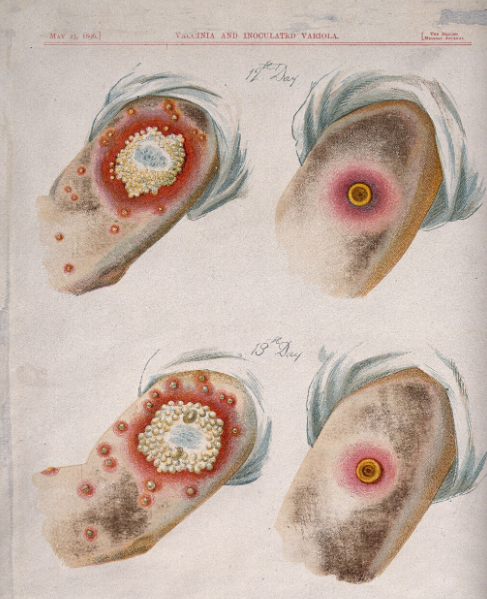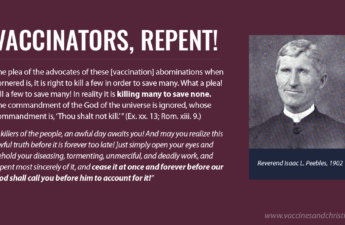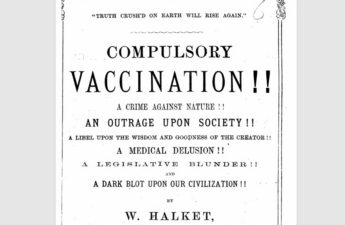
A comparison between smallpox and cowpox pustules on the 12th and 13th days of the disease. Chromolithograph, 1896, after G. Kirtland.
by Steve Halbrook
If you wonder why people will — with no questions asked — inject into their body the dangerous and unsanitary ingredients found in vaccines, then perhaps at least part of the answer is a gradual cultural desensitization to polluting the bloodstream in extremely disgusting ways that began in early vaccine history.
Can we expect society to be opposed to polluting the bloodstream with today’s vaccine ingredients (neurotoxins like mercury and aluminum, the DNA of animals and murdered children, etc.), considering what it was willing to pollute the bloodstream with so long ago? Of course, nowadays, most probably don’t even bother to ask what ingredients are in vaccines. It doesn’t seem to matter — as long as it is called “vaccine.”
Vaccination as we know it began with smallpox variolation in the 1700s. It is technically the forerunner to smallpox vaccination, but in essence it is the beginning of vaccination; vaccination in all but name (and both practices can be referred to as “inoculation,” although normally the former is referred to as such). Smallpox variolation inoculates one with smallpox in the name of fighting smallpox, while smallpox vaccination — which replaced it in the 1800s — inoculates one with cowpox in the name of fighting smallpox. (Smallpox vaccine ingredients would change in the 20th century.)
It is amazing how so many would eventually embrace such an obviously disgusting, unsanitary practice as smallpox inoculation — no matter the form. But let’s start with the first form: smallpox variolation. The following (which refers to it as inoculation) should sufficiently make the point about its filthiness:
The word [inoculation] is derived from the Latin inoculare, meaning “to graft.” Inoculation referred to the subcutaneous instillation of smallpox virus into nonimmune individuals. The inoculator usually used a lancet wet with fresh matter taken from a ripe pustule of some person who suffered from smallpox. The material was then subcutaneously introduced on the arms or legs of the nonimmune person. … However, inoculation was not without its attendant risks. There were concerns that recipients might develop disseminated smallpox and spread it to others. Transmission of other diseases, such as syphilis, via the bloodborne route was also of concern.
Stefan Riedel, “Edward Jenner and the history of smallpox and vaccination, Baylor University Medical Center Proceedings” (January 2005, 18(1): 21–25. Retrieved May 2, 2024, from https://www.ncbi.nlm.nih.gov/pmc/articles/PMC1200696
Simply considering God’s natural design should repel anyone from even entertaining the use of variolation: the perverse procedure is an outrage against God’s created order. God gave us skin as a protective barrier to keep foreign matter out of the blood. Moreover, poisoning one’s blood with diseased filth from another person is incredibly reckless and hazardous. Transferring one person’s bodily fluids to another’s – via the bloodstream, of all things! – opposes the most fundamental principles of hygiene and sanitation.
That smallpox variolation was a sower of disease, instead of a suppresser of it (as time would show), should have easily been anticipated.
[I]t was becoming increasingly evident to thoughtful observers—both lay and professional—that the arm-to-arm inoculation was helping to spread smallpox. The more conscientious physicians were beginning to sense the connection between this form of inoculation and the more frequent appearance of other and worse diseases than smallpox, and a few courageous voices in the profession were outspoken in charging that such blood diseases as erysipelas, syphilis and tuberculosis were transmitted through the arm-to-arm inoculation.
Annie Riley Hale, The Medical Voodoo (New York: Gotham House, 1935), 9.
And so the unnatural process of smallpox variolation/inoculation (injection with human bodily fluids – “inoculated cannibalism”) fell out of favor for, ironically, another unnatural process – smallpox vaccination (injection with animal bodily fluids – “inoculated bestiality”). Smallpox inoculators were vying for power: vaccinators versus variolators.
The resistance to Vaccination was almost entirely confined to the resistance of inoculators [variolators], who were too deeply compromised by their own disloyalty to Nature, to make effective resistance. They were steadily borne down by the vaccinators, many of whom had been energetic inoculators, and displayed the usual ardour of apostates in condemning what they had formerly approved. … Dr. Lettsom had been an inoculator, yet on 2nd July, 1805, he felt warranted in writing—
“What have not the abettors of Variolous Inoculation to answer for ? To shoot a dozen or two innocent people in the public streets of London would not be half so injurious as allowing the murderers to kill the rising generation, the future hope of the State. Nothing can show the supineness and ignorance of the Government more than legalising these Variolous Murders.”
William White, The Story of a great delusion in a series of matter-of-fact chapters (London: E.W. Allen, 1885), 71.
Smallpox variolation was criminalized in the 1800s – but only to be replaced by smallpox vaccination. So the vaccinators gave with one hand and took with another. Or, as William White puts it:
Sometimes when we get the devil out at the door, he presently re- enters by the window ; and thus while Parliament was making an end of Inoculation in one form, it was reviving in another.
Ibid., 75.
Enter vaccination. Dr. Herbert Shelton describes it as thus:
Vaccination is the inoculation of child or adult, well or sick, with septic matter (pus) derived from suppurating (festering) sores on the abdomen of a previously infected cow. I think this definition is incomplete in an important respect—I should have said that it is a criminal operation.
Herbert Shelton, Vaccines and Serum Evils (c1940’s). Retrieved May 13, 2015, from http://www.whale.to/vaccines/shelton3.html
But it is actually worse than this. Smallpox vaccination not only related to the bodily fluids of cows, but to horses. Edward Jenner, the popularizer of the smallpox vaccine,
had observed that cowpox occurred in farms where both men and women worked with dairy cows, which led him to postulate that the origin of cowpox was in fact another disease that affected horse’s hooves called horse grease (horsepox).
Rusnock, A. A. (2016). “Historical context and the roots of Jenner’s discovery.” Human Vaccines & Immunotherapeutics, 12(8), 2025–2028. https://doi.org/10.1080/21645515.2016.1158369
And so smallpox vaccination could involve both the diseased secretion from a cow’s teat and the diseased secretion from a horse’s hoof. While the public was disgusted by the latter, it was puzzling that it accepted the former. William White writes,
Jenner published his Inquiry in order to recommend horsegrease cowpox, and what I have to say is, that the public declined to have anything to do with horsegrease cowpox. The origin of cowpox in horsegrease was scouted as an intolerable origin. It was disgusting. Why a diseased secretion from horses’ heels should be more repulsive than a similar secretion from cows’ teats was not explained ; but, as we all know, there is no accounting for tastes.
William White, The Story of a great delusion in a series of matter-of-fact chapters (London: E.W. Allen, 1885), xiv, xv.
And so there would be three kinds of smallpox vaccines:
By the time Jenner died in 1823, three kinds of smallpox vaccination were in use: 1) cowpox — often promoted as “pure lymph from the calf,” 2) horsepox, or horsegrease injections, promoted as “the true and genuine life-preserving fluid,” and 3) horsegrease cowpox, the foul concoction originally promoted in Jenner’s Inquiry. All were known to cause suffering and death.
Neil Z. Miller, Vaccine Safety Manual: For Concerned Families and Health Practitioners (Santa Fe, NM: New Atlantean Press, 2015), 32.
Given the incompability of human and animal physiology, it shouldn’t take much thought to figure out that such a procedure will wreck havoc on one’s health. Here’s a specific example from Annie Riley Hale – the sudden explosion of cancer after cowpox/horsepox vaccination was unleashed on the public:
Indeed there is good ground for believing the doctor’s inoculating hypodermic a more fruitful generator of cancer poison than any of those listed by Mr. Barker. For besides introducing poison directly into the blood-stream, these animal “bio-products” also introduce products of a new kind of cell—different from the human cell—and one which normally reproduces itself much faster than the human. What more reasonable inference than that this foreign cell material should start up in the human body the too-rapid cell-proliferation which is the outstanding feature of cancer?
There are not lacking medical men of high standing to testify to the soundness of this conclusion. William Scott Tebb in his book, The Increase in Cancer, quotes a number of eminent authorities—among them Dr. Wm. Forbes Laurie, late medical director of the Metropolitan Cancer Hospital, London—as being “thoroughly convinced that continuous, persistent vaccination is an important contributing cause of cancer increase.” Dr. F. P. Millard, a prominent osteopath of Toronto and president of the National League for Prevention of Spinal Curvature, says: “Abolish vaccination, and you will cut the cancer death-rate in half.”
Annie Riley Hale, The Medical Voodoo (New York: Gotham House, 1935), 107.
Smallpox vaccination didn’t only involve shoving diseased animal fluids into the bloodstream. Like smallpox variolation, it would also be the diseased fluids of other people. This is because the practice was arm-to-arm – from one person to another:
Arm-to-arm became the primary method for keeping viable stores of cowpox lymph. Most often children would be carriers on long journeys. A group of them would be taken to travel, with the children being vaccinated one by one over the course of the voyage to keep a supply going. This was also how supplies were spread when introduced to a new country, using those who had an infection from their vaccination to vaccinate others. It worked to an extent, but transmission chains were sometimes interrupted, and because cowpox didn’t occur everywhere, if supplies ran dry, new supplies were needed.
Indiana University Bloomington, “History of the Smallpox Vaccine: Vaccination Discovered.” Retrieved June 21, 2024, from https://collections.libraries.indiana.edu/iulibraries/s/smallpox-vaccine-exhibit/page/vax-main
So in smallpox vaccination you had the diseased filth from both animals and humans! Hardly an improvement from smallpox variolation – really, a greater perversion. That such a foolish and reckless procedure was dangerous goes without saying.
Until the technique of harvesting lymph directly from calves and heifers was developed in the 1850s and 1860s, arm-to-arm transfer remained one of the primary means by which cowpox was maintained. But there were problems with this technique. Lancing the lesion to collect lymph exposed the patient to erysipelas, an infectious skin disease, and to other infections. By the mid-nineteenth century, physicians began arguing that syphilis could be transmitted, and in India, it was feared that leprosy was spread by this means. Arm-to-arm vaccination also violated ideas of bodily integrity, which was why those with little power, foundlings and the poor, were generally used as sources for lymph.
Andrea Rusnock, “Catching Cowpox: The Early Spread of Smallpox Vaccination, 1798–1810,” Bulletin of the History of Medicine, Volume 83, Number 1, Spring 2009, pp.
17-36 (Article) (Published by The Johns Hopkins University Press DOI: 10.1353/bhm.0.0160), 29, 30.
And from another author, who, based on language in the cited article, is pro-vaccine:
During the first eighty years the vaccine was being transferred almost exclusively from arm to arm with the risks inherent in this procedure; one of the reasons for applying this method was the fear of “bestialization” thought to be linked with the use of material of animal origin. Several contaminations have been observed as a result of the use of the arm-to-arm procedure: smallpox was transmitted, especially in the beginning, because vaccinations were carried out in a contaminated environment. Syphilis was diagnosed in several countries after the use of vaccine taken from syphilis patients. At least two foci of hepatitis were reported after the use of contaminated human lymph. …Varicella and measles were transmitted from time to time with the vaccine and also bacterial infections, such as staphylococci, streptococci e.a.
C Huygelen, “Jenner’s cowpox vaccine in light of current vaccinology,” Verh K Acad Geneeskd Belg. 1996;58(5):479-536; discussion 537-8. Dutch. PMID: 9027132. Retrieved June 21, 2024, from https://pubmed.ncbi.nlm.nih.gov/9027132
According to Dr. William Howard Hay, diseased matter from corpses were even used:
It is nonsense to think you can inject pus-and it is usually from the pustule of the dead smallpox victim; that is the basis of it; we used to think it was from cowpox, but the manufacturers deny that and say the most reliable form originates in the pustule of someone who had died from smallpox-it is unthinkable that you can inject that into a little child and in any way improve its health.
Dr. William Howard Hay, Address to The Medical Freedom Society (June 25, 1937). Retrieved May 12, 2015, from http://www.whale.to/v/hay1.html
Mahatma Gandhi himself was opposed to vaccination, and wisely observes:
[V]accination is a very dirty process, for the serum which is introduced into the human body includes not only that of the cow, but also of the actual small-pox patient. An average man would even vomit at the mere sight of this stuff. If the hand happens to touch it, it is always washed with soap. The mere suggestion of tasting it fills us with indignation and disgust. But how few of those who get themselves vaccinated realise that they are in effect eating this filthy stuff ! Most people know that, in several diseases, medicines and liquid food are injected into the blood, and that they are assimilated into the system more rapidly than if they were taken through the mouth. The only difference, in fact, between injection and the ordinary process of eating through the mouth is that the assimilation in the former case is instantaneous, while that in the latter is slow. And yet we do not shrink from getting ourselves vaccinated ! As has been well said, cowards die many times before their death, and our craze for vaccination is solely due to the fear of death or disfigurement by small-pox.
Mahatma Gandhi, A Guide to Health (Triplicane, Madras, S.E.: S. Ganesan, 1922), 108, 109.
Vaccination lacked control over diseases that could be unleashed into the bloodstream. William White, in his 1885 book The Story of a great delusion quotes a one William Cobbett and follows up with his own observations:
“Who is to collect this genuine matter, and whence is it to come ? Who shall tell whether he inoculate with Cowpox or King’s Evil ? Or with many other disorders, one of which I will not name, but which I do hope, that fathers and mothers who have given their children that greatest of blessing, a pure stream of blood, will not forget when they are about to cause that blood to be impregnated with matter taken from the ulcerous bodies of others.”
In this latter warning, we have to remark Cobbett’s prescience. He knew that it was impossible to transfer organic virus from arm-to-arm without transferring more than was intended, inclusive of the dreadful disease he indicated. Vaccinators naturally denied the possibility of such extra transmission ; for if they had admitted the possibility, they must have ceased to vaccinate.
William White, The Story of a great delusion in a series of matter-of-fact chapters (London: E.W. Allen, 1885), 309, 310.
Vaccination was really a game of disease roulette. You never knew what you were going to get. It could be any number of diseases from the bodily fluids of cows, horses, people, and corpses.
And so vaccination – whether in the form of smallpox variolation/inoculation, or vaccinated cowpox/horsepox that replaced it – got off to a bad start. They were two sides of the same disgusting, unsanitary, and unscientific coin. In 1882, Dr. Rufus King Noyes writes:
Inoculation and vaccination have common characteristics. Vaccination, like inoculation, is inefficient, contagious, dangerous, and, in many cases, fatal. Both are devoid of science and sense ; both are identical, except in severity ; both are called substitutes for small-pox ; both were recommended because of their so-called relative mildness. Both, being untimely and without epidemical dependencies, are artificial. Being thus artificial, both are contrary to nature. Being contrary to nature, both are antagonistic to medical science. The object of medical science is to assist nature. Nature’s scavenger and sanitary agent, ozone, has not assisted vaccination nor inoculation. To breed and cultivate pus, virus, disease, death, is not as-sistance to nature. Nature is incessantly removing filth and putrescence. Vaccinators are multiplying the same. Hence antagonism to nature.
Rufus King Noyes, Nature and Vaccination, The Vaccination Inquirer and Health Review, Vol. IV, No. 38, May 1882, in The Vaccination Inquirer and Health Review, Volume the Fourth, April 1882 to March 1883 (London: Edward W. Allen, 1883), 27.
These disgusting, unsanitary beginnings of vaccination set the tone for the increasingly insane use of dangerous ingredients used in vaccines today.
If you find this site helpful, please consider supporting our work.


